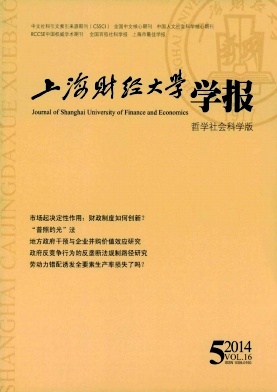创新集群发展的“东亚模式”:基于日、韩数据的实证检验
上海财经大学学报 2014 年 第 16 卷第 05 期, 页码:104 - 112
摘要
参考文献
摘要
文章以东亚创新集群发展的代表性国家——日本、韩国的2001-2010年数据为样本,利用全局空间相关性检验—Moran I指数检验了日本、韩国地区创新集群发展的基本形态及演变特征。为了避免由于模型设定所导致的推断错误,文章利用初始GMM估计方法、完全加权GMM估计方法和部分加权GMM估计方法,构建静态空间面板模型,检验大学、国有研究机构、风险资本、政府的政策倾斜以及大企业、中小企业各自在东亚创新集群发展中的作用,以此揭示东亚创新集群的发展模式。实证检验显示,创新集群发展存在"东亚模式",其与"美国模式"的本质区别在于创新集群产生与发展的关键驱动要素不同,"东亚模式"具有"跨越式"追赶的特征,但却未能发挥大学等知识部门的潜能。我国可以通过吸纳两种创新集群的发展模式,结合本国经济发展的实际情况进而采取灵活的政策措施,使两种模式相互促进并形成良性互动。
[1]范硕,李俊江.创新体系的“韩国模式”:URIs与集群的作用[J].科学学与科学技术管理,2011,(6).
[2]范硕,李俊江.剑桥大学科技商业化的经验及启示[J].中国科技论坛,2011,(6).
[3]范硕,李俊江.西方创新集群研究最新进展评述[J].科技进步与对策,2012,(1).
[4]姜磊,季民河.城市化、区域创新集群与空间知识溢出[J].软科学,2011,(12).
[5]金东柱.知识信息时代的产业区位与集群体系研究[R].韩国国土研究院咨询报告,2001.
[6]平川均,崔龙浩.东亚的产业集聚:形成、机制与转型[M].北京:社会科学文献出版社,2011.
[7]吴玉鸣,何建坤.研发溢出、区域创新集群的空间计量经济分析[J].管理科学学报,2008,(4).
[8]项歌德,朱平芳,张征宇.经济结构、R&D投入及构成与R&D空间溢出效应[J].科学学研究,2011,(2).
[9]Braunerhjelm P.,Carlsson B.Industry Clusters in Ohio and Sweden,1975-1995[J].Small Business Economics,1999,43(12):297-293.
[10]Choi J.Research on Manufacturing Clusters and Regional Specialization in Korea[J].Korea Regional Study,2005,2(1):55-90.
[11]Conley T.G.GMM Estimation with Cross Sectional Dependence[J].Journal of Econometrics,1999,92(1):1-45.
[12]Cooke P.,Laurentis C.,Todtling F.,and Tripple M.Regional Knowledge Economies:Markets,Clusters and Innovation[M].Edward Elgar,2007.
[13]Engel J.S.,Palacio I.T.Global Networks of Clusters of Innovation:Accelerating the Innovation Process[J].Information&Management,2009,52(7):493-503.
[14]Ernst D.Innovation Offshoring:Asia’s?Emerging Role in Global Innovation Networks[R].East-West Center Special Reports,No.10,2006.
[15]Kapoor M.,Kelejian H.H.,Prucha I.R.Panel Data Models with Spatially Correlated Error Components[J].Journal of Econometrics,2007,140(1):97-130.
[16]Kitagawa F.International R&D Alliances and Clustering in East Asia:Implications for the Multi-Scalar Governance of Science and Innovation[R].Presented at Gothenburg University,2December 2010.
[17]Tsuji M.,Kuchiki A.From Agglomeration to Innovation:Upgrading Industrial Clusters in Emerging Economies[M].Pragrave Macmillan,2009.
[18]Risaburo N.Technology Transfer,Intellectual Property and Effective University-Industry Partnerships:The Experience of China,India,Japan,Philippines,the Republic of Korea,Singapore and Thailand[M].Geneva:WIPO,2005.
[19]Shapira P.Putting Innovation in Place:Policy Strategies for Industrial Services,Regional Clusters,and Manufacturing SMEs in Japan and the United States[J].Advances in the Japanese Innovation System,2008,26(1):69-87.
1该指数包含了企业创新量、创新能力和研发质量等指标。
2主要体现在通过中央政府的资金支持发展创新集群。
3指公司研发的国际化,伴随着公司研发活动的开放性和国际合作。
1估计过程使用了美国Maryland大学Ingmar R.Prucha教授所编写的空间面板GMM估计的Stata程序。
[2]范硕,李俊江.剑桥大学科技商业化的经验及启示[J].中国科技论坛,2011,(6).
[3]范硕,李俊江.西方创新集群研究最新进展评述[J].科技进步与对策,2012,(1).
[4]姜磊,季民河.城市化、区域创新集群与空间知识溢出[J].软科学,2011,(12).
[5]金东柱.知识信息时代的产业区位与集群体系研究[R].韩国国土研究院咨询报告,2001.
[6]平川均,崔龙浩.东亚的产业集聚:形成、机制与转型[M].北京:社会科学文献出版社,2011.
[7]吴玉鸣,何建坤.研发溢出、区域创新集群的空间计量经济分析[J].管理科学学报,2008,(4).
[8]项歌德,朱平芳,张征宇.经济结构、R&D投入及构成与R&D空间溢出效应[J].科学学研究,2011,(2).
[9]Braunerhjelm P.,Carlsson B.Industry Clusters in Ohio and Sweden,1975-1995[J].Small Business Economics,1999,43(12):297-293.
[10]Choi J.Research on Manufacturing Clusters and Regional Specialization in Korea[J].Korea Regional Study,2005,2(1):55-90.
[11]Conley T.G.GMM Estimation with Cross Sectional Dependence[J].Journal of Econometrics,1999,92(1):1-45.
[12]Cooke P.,Laurentis C.,Todtling F.,and Tripple M.Regional Knowledge Economies:Markets,Clusters and Innovation[M].Edward Elgar,2007.
[13]Engel J.S.,Palacio I.T.Global Networks of Clusters of Innovation:Accelerating the Innovation Process[J].Information&Management,2009,52(7):493-503.
[14]Ernst D.Innovation Offshoring:Asia’s?Emerging Role in Global Innovation Networks[R].East-West Center Special Reports,No.10,2006.
[15]Kapoor M.,Kelejian H.H.,Prucha I.R.Panel Data Models with Spatially Correlated Error Components[J].Journal of Econometrics,2007,140(1):97-130.
[16]Kitagawa F.International R&D Alliances and Clustering in East Asia:Implications for the Multi-Scalar Governance of Science and Innovation[R].Presented at Gothenburg University,2December 2010.
[17]Tsuji M.,Kuchiki A.From Agglomeration to Innovation:Upgrading Industrial Clusters in Emerging Economies[M].Pragrave Macmillan,2009.
[18]Risaburo N.Technology Transfer,Intellectual Property and Effective University-Industry Partnerships:The Experience of China,India,Japan,Philippines,the Republic of Korea,Singapore and Thailand[M].Geneva:WIPO,2005.
[19]Shapira P.Putting Innovation in Place:Policy Strategies for Industrial Services,Regional Clusters,and Manufacturing SMEs in Japan and the United States[J].Advances in the Japanese Innovation System,2008,26(1):69-87.
1该指数包含了企业创新量、创新能力和研发质量等指标。
2主要体现在通过中央政府的资金支持发展创新集群。
3指公司研发的国际化,伴随着公司研发活动的开放性和国际合作。
1估计过程使用了美国Maryland大学Ingmar R.Prucha教授所编写的空间面板GMM估计的Stata程序。
引用本文
范硕, 何彬, 谭少梅. 创新集群发展的“东亚模式”:基于日、韩数据的实证检验[J]. 上海财经大学学报, 2014, 16(5): 104–112.
导出参考文献,格式为:





 7110
7110  195
195

